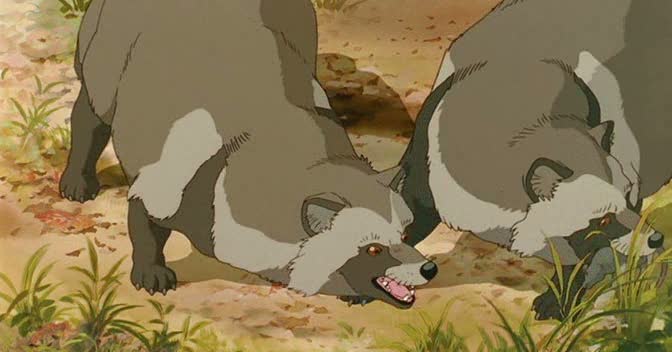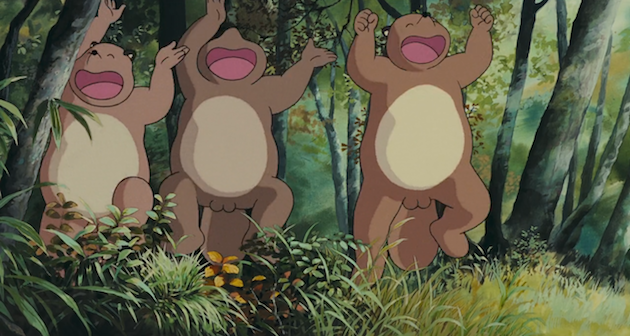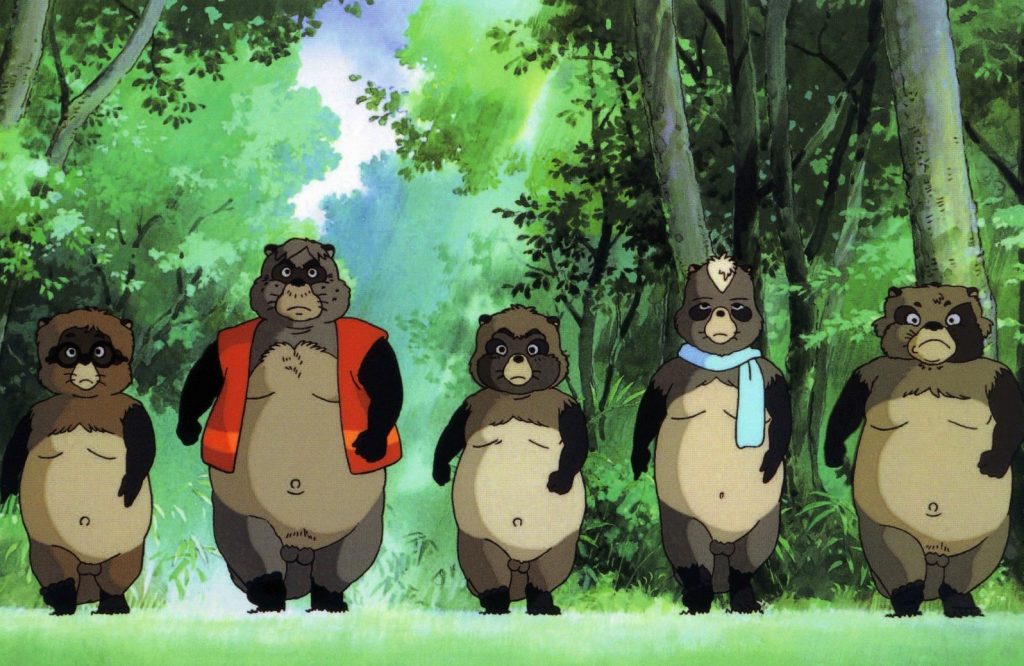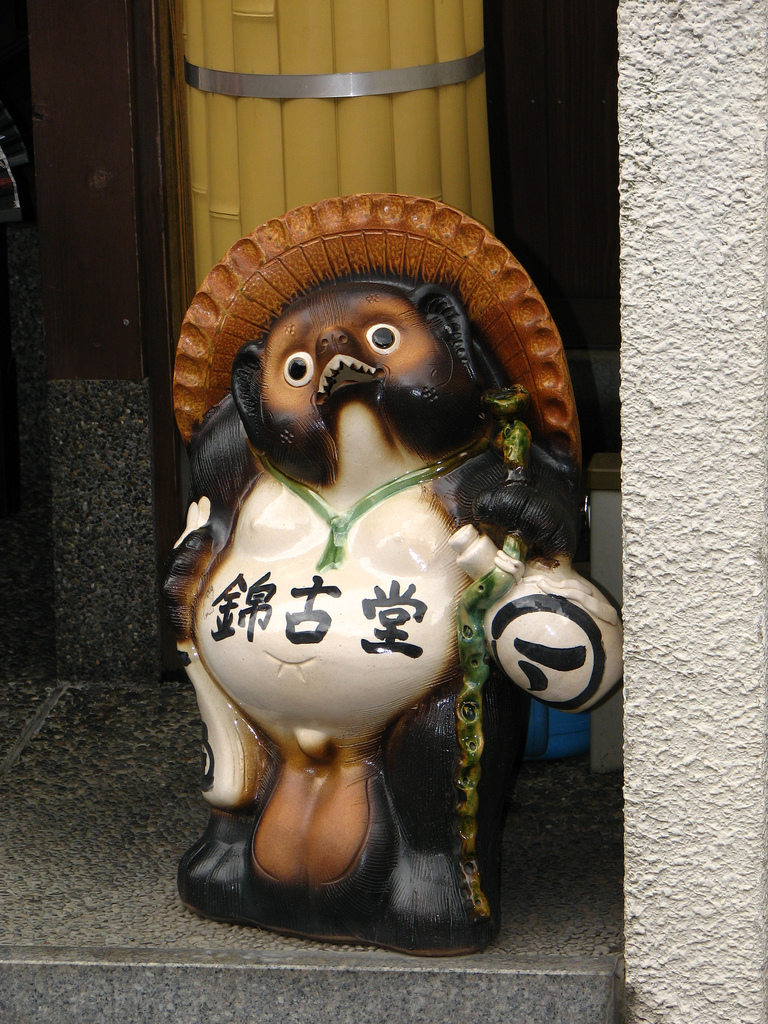Pom Poko. Dir. Isao Takahata. Studio Ghibli. 1994
Pom Poko (Heisei Tanuki Gassen Ponpoko) is written and directed by Isao Takahata, a co-founder of Studio Ghibli which animated and published the movie in 1994. The story takes place during the late 1960s at the edge of the Tokyo sprawl. A housing project, aimed at expanding the city even further, endangers the habitat of a group of tanuki, raccoon dogs, to be excavated. The tanuki, portrayed with round eyes, a belly like Buddha and pendulous testicles, are common figures of the Japanese folklore, known for their ability to shape-shift. At the beginning of Pom Poko, raccoon dogs are fighting each other due to the lack of natural resources in their forest. However, soon they realize that their real enemy are the workers. Making use of their capacity to shape-shift, the raccoon dogs attempt to scare the workers away and thus impede them from continuing their work. But will this really suffice to maintain the pastoral idyll in which they live?
With regard to the genre, this movie includes a huge variety of them. Most of Studio Ghibli’s works hybridize several genres at once, so as to be multi-layered and hence offer various perspectives on a certain topic. Similar to other Studio Ghibli movies, such as Princess Mononoke, Pom Poko is closely related to Japanese with its aspects of Japanese folklore, because tanuki play a crucial role in there. Obviously, it is an animated movie, as is the rest of this Studio’s work.
Moreover, Isao Takahata is best known for his highly sentimental, sadness evoking “Grave of the Fireflies”. Pom Poko also is a drama, however, while the tone is rather somber, a few light-hearted instances prevent this movie to be overall depressing too. Given the fact that the raccoon dogs are able to transform into human beings, speak and even write, the movie contains supernatural as well as fantasy elements. Above all, unlike other Ghibli movies, which focus mainly on love stories, this fast-paced piece is an adventure of nature against human intervention, providing yet another view on the matter and making use of funny, dramatic and charming moments.
According to Le Blanc and Odell (2015), most of Isao Takahata’s movies are adaptations from novels or mangas, which usually are set in the real world. Oftentimes, the plot takes place in Japan, making references to ancient traditions or folklore, which are easily overseen if one is not familiar with them. As already mentioned above, the tanuki are able to shape-shift, which is found in very early writings of Japanese recordings. Unlike foxes, who also are known to have that ability, tanuki tend to be more comical tricksters, often taking the form of a Buddhist monk (cf. Foster, 2012). While the tanuki are very fun-loving as well as being really fond of treats, they usually do not pose a real threat. Foxes on the other hand are known to take forms of women and seduce these women’s husband, causing havoc.
To be more specific, in Pom Poko, transformation processes come in a variety of forms, depending on the state of mind of the individual tanuki, reaching from minor objects such as tea pots, to the full-scale transformation into a human being (cf. Le Blanc & Odell, 2015). While some of the tanuki are able to perform the transformation without any effort, many already have forgotten how to do it, as in previous peaceful times its necessity became redundant. Moreover, the visual representation of the tanuki is shown in three different stages: the realisticly depicted version when they encounter human beings (Figure 1), the cartoony representation when they are about to do something whimsical (Figure 2) and the anthropomorphic throughout the rest of the movie, often even wearing clothes (Figure 3).



In folklore, the tanuki’s magic is often related to his gigantic scrotum, which is also shown in the movie quite clearly. In contemporary Japan, the tanuki thus represents prosperity and fertility and is found in front of restaurants, shops and even temples (see Figure 4).

The tanuki’s struggle to maintain their natural habitat is another main topic of the movie. While the depicted humans follow their housing project in the Tama Hills, the tanuki aim at preserving nature and defend it at all costs. For this, it is crucial that they possess all the skills prescribed to them in folklore, as otherwise they could not oppose the machinery with which humans are destroying the countryside. The concept of human vs. nature is a topic which is found in many Studio Ghibli movies. Commonly, earth is portrayed as suffering from human intervention, reaching from pollution in “Nausicaä of the Valley of the Wind”, the effects of war on a country in “Grave of the Fireflies”or environmental destruction in “Pom Poko”. Due to these reasons, nature often has to find a way to adapt in order to survive (cf. Le Blanc & Odell 2015).
So after various different attempts to cease the construction, such as killing the workers, or haunting the city in a parade of transformation (depicting several creatures from Japanese folklore again), which are all in vain, the tanuki finally decide to transform into humans and be part of the society. Those who are not able to do so are left behind, either fleeing the country, or getting swallowed by human progression. Yet, a last attempt to save the habitat through openly appealing to the public, the workers are pushed to at least maintain some parks for the remaining tanuki who cannot transform, so at the end most of them blend into society and the rest continues living on a golf course. The quint essence of the movie is shown at the end of it. A tanuki is facing the camera directly, stating that even with the emergence of the new development the problem of the tanuki’s presence has been solved, however, it is only through their adaptation that they were able to survive. The idea is thus that humans should care more for them, as they already took away all their natural habitat and be more respectful towards them if they see some tanuki roaming the city.
So again, the focus of the movie Pom Poko certainly lies on the daily struggles of the tanuki in the face of deforestation and destruction of their natural living conditions through humans.
This is not only depicted in the movie, but also is a current matter causing problems in contemporary Japan. Takahata himself stated that “the film is not so much fiction as a documentary of the destiny of the raccoon dogs as seen through their own eyes” (The Daily Yomiuri, 1994). Humanizing the tanuki and using their point of perspective, Takahata opens up new perceptions to the problem at hand. During the 1980s and 1990s the tanuki already infiltrated Tokyo due to a lack of natural habitat and were thenceforth feeding on the trash of people. Ever since, they are struggling to maintain their lives, as many suffer from diseases.
With the background of Japanese folklore, the capacity of the tanuki to transform is provided, which also plays a crucial role in the representation of them. In any given situation, the tanuki are able to adapt, be it for reasons of outer appearance or out of a need to adapt to a new world surrounding them. However, as real tanukis are inable to shape-shift, the appeal for considering their fates is made in this movie. For the audience, it is also much easier to identify with the tanuki if perceived in their humanized form, but still be reminded of their original form when seen by human beings. Due to this, Takahata appeals to the audience to always consider both sides of human progression and be more respectful towards an animal, which plays such an important role in the representation of Japan’s history as well as present.
Personally, I am a huge fan of Studio Ghibli, be it Takahata’s or Miyazaki’s works. In several of their movies, animal presence is a major topic, often entailing environmental issues of modern society. Pom Poko specifically addresses the problem of human intervention in nature, as it also can be partly seen in “Princess Mononoke”. Furthermore, I must admit that these movies always keep one’s thoughts busy. Both old and young, everyone can learn a lot from them, above all in regard to animal perception.
At first, the connection to ancient traditions was not clear to me, but understanding it further, one can imagine this tale even better and plunging into the reality of this movie is hence facilitated. However, this shows again that the movie is not purely made for children, as it is multi-layered and thus not easy to understand without any prior knowledge, even though the basic idea should stick with everyone.
Bibliography:
Michael Dylan Foster “Haunting Modernity: Tanuki, Trains, and Transformation in Japan”. Asian Ethnology. 2012.
Colin Odell & Michelle Le Blanc, “Studio Ghibli, The Films of Hayao Miyazaki and Isao Takakata” Oldcastle Books. 2015.
The Daily Yomiuri in Cavallaro, D. The Anime Art of Hayao Miyazaki. North Carolina: McFarland & Company. 2006.
Filmography:
Pom Poko. Dir. Isao Takahata. Studio Ghibli. 1994